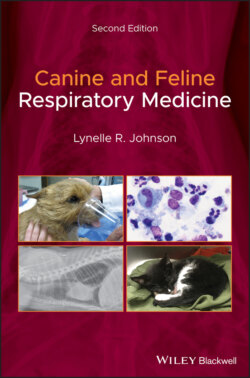Читать книгу Canine and Feline Respiratory Medicine - Lynelle Johnson R., Lynelle R. Johnson - Страница 32
2 Respiratory Diagnostics General Laboratory Testing
ОглавлениеBasic blood work – complete blood count (CBC) and biochemical panel – in combination with a urinalysis is often performed during the work‐up of a respiratory patient and can help support the presence of an underlying respiratory tract disease. With local infectious or inflammatory disease processes such as rhinitis and tracheobronchitis, hematologic changes are typically absent. In contrast, with parenchymal diseases such as bacterial or aspiration pneumonia or pyothorax, a neutrophilic leukocytosis is often found and a left shift on the leukogram supports the diagnosis of an infectious process. Neutrophilia or eosinophilia is reported in eosinophilic pneumonia/bronchopneumopathy and feline bronchial disease. Fungal pneumonia is anticipated to result in neutrophilia and monocytosis, reflecting the chronic nature of the disease. Chronic hypoxemia can result in polycythemia, although this is more common with right to left cardiac shunts. The presence of nucleated red blood cells can be an indicator of hypoxemia that has triggered bone marrow toxicity.
Biochemical abnormalities in respiratory diseases are usually non‐specific. Hyperglobulinemia can be found in feline bronchial disease, fungal pneumonia, chronic foreign body or aspiration pneumonia, or bronchiectasis due to chronic antigenic stimulation, and concurrent hypoalbuminemia is occasionally present as a negative acute phase reactant.
Molecular diagnostics are increasingly used to document the presence of an infectious organism, such as feline herpesvirus‐1, Bordetella, or Mycoplasma, in either upper or lower respiratory tract disease; however, there are important limitations to the interpretation of these results (see the sections on specific diseases). Also, it is critical to realize that a positive molecular assay indicates only the presence of nucleic acids of the organism, and does not confirm that the organism is responsible for the clinical disease identified.
Various biomarkers have been evaluated as a method for differentiating cardiac from respiratory disease in animals presenting for cough or respiratory difficulty. The most common biomarker evaluated is plasma N‐terminal pro‐brain natriuretic peptide (NT‐BNP), which is produced in response to ventricular strain or stretch. A commercially available enzyme‐linked immunosorbent assay (ELISA) test is available for dogs and cats, and a point‐of‐care in‐house test has been developed for cats. This biomarker is reliably elevated in dogs with congestive heart failure in comparison to dogs with respiratory disease; however, there is some overlap between groups and often the non‐cardiac causes of respiratory distress are poorly defined. It is unclear whether this test is of added benefit in comparison to history, physical examination, and ultrasound in dogs that have both cardiac and respiratory disease. A point‐of‐care test is available for assessing values for feline NT‐BNP, and this can be applied to serum and pleural effusion fluid. Positive BNP tests in combination with appropriate cardiac and lung ultrasound examination could reliably establish congestive heart failure as the cause of respiratory distress, although the plasma BNP test was elevated in over 25% of cats with respiratory distress that was not due to cardiac disease (Ward et al. 2018). Renal disease can also increase BNP levels, therefore caution is warranted in relying on a single test for a diagnosis.
